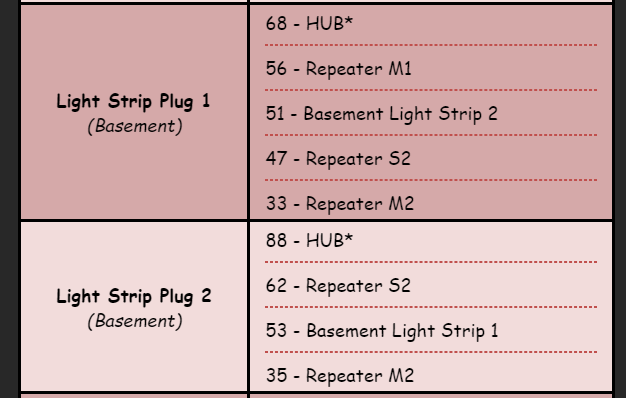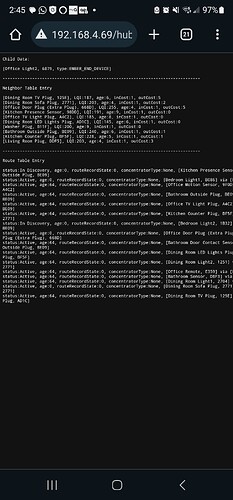I have spent so much time trying to troubleshoot my issues just tl avoid having to make this post but I dont know what else to do at this point. My hub stays online but the devices either take forever to respond or they simply do not. I have multiple sengled bulbs in a chandelier. One will turn on while the other won't. When i check the device page, it will show on but the bulb will be physically off and bice versa. At times both will simply not respond. Smart buttons work sporadically, motion sensors will turn on the lights, get stuck in an active status causing the lights to stay on when they shouldnt. At times I'll see the light indicator flash, showing it detected motion but it doesnt trigger my automations. Upon checking device page, it shows motion inactive...like wtf. Devices miss checkins (saw that in logs). I have tried removing all devices, readd repeaters in the form of 8 third reality smart plugs then the end devices one by one. 8 smart plugs are overkill becuase my house is only 1500 sqft but i kept seeing this BS about strong mesh, so i went overboard to ensure signal makes it around every corner but response times are so slow or like i said, doesnt respond at all. i checked my zigbee mesh after only adding the repeaters and i saw a whole bunch of unkown devices. As i readd my devices the number of unkowns slowly reduced. i ran away from smartthings becuase i started experiencing drops but this is crazy. i spend more time dealing with issues than enjoying the conveniece of automations. Any help in this matter will be greatly appreciated. The only thing i havent done is just wipe the damn hub and start over from scratch. Oh, before i forget, some devices simply are no longer discoverable by the hub but i can easily add them to their manufacturer's hubs.
Sounds like a mesh issue. Sounds like you have some appreciation for how Zigbee works.
Sub in your IP and have a look at your Zigbee routing table @ (http://192.168.0.200/hub/zigbee/getChildAndRouteInfo)
Post a picture up here.
Child Data = Child devices connected direct to the hub.
Neighbor Table Entry = Devices that are one hop from the hub (direct neighbors). It will look something like this: [Repeater M3, 1E12], LQI:155, age:4, inCost:7, outCost:7
My guess is that the devices listed above this line are all working reliably if the LQI is decent.
Route Table Entry = How to reach devices that are not direct neighbors. It will look something like this. [Furnace Leak Sensor, 200B] via [Basement Light Strip 2, B406]
My guess is the unreliable devices are mostly in this group.
Don't expect every device to appear in this listing.
As an aside, I see you chose an IP address of .200 for your hub. Do you have a c8 by any chance? 200 = c8 in hex. If you did this on purpose, my hat is off to you ![]()
What version hub do you have and what platform are you on?
What channel is your wifi network on and what channel is your zigbee on?
What brand/model of sensors are falling off?
Are you having issues with z-wave
I'm not sure what you mean by this... Are you using a hue bridge or a lutron bridge or are these wifi devices?
I wish I could say that I did, but you get to keep your hat on.
My addressing philosophy is big devices on big round numbers.
Based on the symptoms you've shared, everything points to a troubled mesh. As you've pointed out, one way to resolve radio interference is to add mains powered devices to make the mesh more resilient to interference but that may not be enough to resolve the problems. Zigbee devices that stop reporting or work intermittently, or simply drop off the mesh are all indicative of interference. Perhaps the same reason you may have had problems with Smartthings hub too. I would start by screening your location for 2.4ghz channels overload, then maybe moving the Zigbee channel away from the congested Wi-Fi channels. Also having multiple Zigbee controllers active at the same time can lead to the poor experience you've been having.
Last but not least, I wish you had posted in the community about your struggles earlier, so that our staff and active users can help you avoid the frustration. Some of the Zigbee cases I have seen can be utterly annoying. I had my share of Zigbee frustrations in the past, so I know exactly how you feel.
I'm using C-8 on the latest version. I am on the current version. I use eero pro 6 router and the 2.4ghz band is between channel 1 and 9. Zigbee is on channel 20. i had boosted the power from 8 to 20 but reverted to 8 once the problems persisted. As for sensors, i use tuya and third reality. i tried aqara because i had them from smartthings but i stopped using them. I also use wiz and sengled bulbs. Sengled are the problematic ones. i have no zwave devices. As the the last note, my aqara smart button worked perfectly before i attempted to rebuild the mesh. Now it won't get discovered when i attempted to readd it to C-8. However i can easily add it to the aqara hub.
Could it be that my attempt to remedy my situation with multiple repeaters may be adding to my problems?
Have you tried a higher Zigbee channel, like 24 or 25? Also, you can boost the Zigbee power, maybe not to 20, but try 16.
Thread is on channel 25 but only my echo devices and two eve motion sensor from smartthings days are on there. I'll give it a go and see what happens.
Try 24, then.
It should not. Fundamentally your Neighbor Entry table "looks" pretty solid with decent LQI's and a lot of neighbors. When you control these devices the hub talks directly them and eliminates problems that might relate to secondary signal repeaters.
I have a little experience with the Third Reality plugs I have not been impressed, so my mind jumps to those as the possible culprits. These are my two:

Notice the LQI reading from the Repeater POV to the HUB are 68 and 88. Physically they are about 10-15ft from the hub in the same room and nothing but open space.
The HUB sees the connections to the same two repeaters as LQI 254 and 255 respectively.
So if I'm seeing 254 & 68 and you are getting 200 & ? then your LQI is probably pretty low. For reference XBEE considers an LQI of 65 and less to be weak.
I'd suggest you try my Zigbee Monitor Driver [RELEASE] Zigbee Monitor Driver - Like XRAY Vision for Zigbee Repeaters and simple Switches on a couple of devices and it will give you a view of the Zigbee network from the repeaters POV. You don't need the table part, you will be able to see the values in the device driver.
I'm guessing you have been moving devices around a lot and\or re-adding them which is understandable, but it can aggravate the troubleshooting as the Zigbee network can be slow to heal itself.
For example, a non-repeating device such as your Sengled bulbs, will have ONE device which they consider to be the parent and will attempt to route all activity through that parent. It will hang onto that connection even if it is weak and only change it's parent when the original connection is lost. This is why they recommend adding devices from the location in which they will permanently reside vs right next to the hub. Note the above driver can also show a list of child devices with their LQI as shown below.

You seem to have a technical leaning so I hope this makes sense to you.
Which Third Reality plugs? The Power metering or the normal ones? The power metering ones are VERY chatty. There is a firmware update which fixes it a little.
I'll add my two cents... many of the cost and age figures in your neighbor table aren't good; most of the repeaters within one hop of your mesh aren't doing much that's productive.
Note that not every neighbor needs to be 'good', but you need a sufficient number of good ones (based on the age and Cost numbers; the routing algorithm avoids the bad ones) to extend coverage to the to furthest reaches of your mesh.
I've highlighted things that jump out .... in a nutshell, on acceptable neighbor links, the age counters won't exceed 4 (on functional links the age counters get bumped every time 15 sec. elapses and reset to '2' when link status is received).
If they exceed 4, then consecutive status reports are being missed.. It's likely that the signal from the neighbor is subject to interference or possibly being attenuated by building materials or reflections. Lower (but nonzero) cost numbers correlate with better LQI's (the outCost is an indication of LQI at the neighbor's receiver) and are given preference by the routing strategy. outCost '0' is a special case meaning link status isn't being received at all, or is 'stale'.
Try relocating the marginal repeaters if possible; you should see the change (if there is one) reflected in the numbers within a minute or so... that table isn't static. If the situation doesn't improve (and you've already tried choosing a channel with minimal overlap with your wifi) you might need a repeater or two closer to the hub.. Zigbee range indoors (due to building materials) doesn't come close to the 'free air' nominal figure.
This topic was automatically closed 365 days after the last reply. New replies are no longer allowed.




